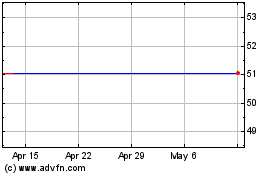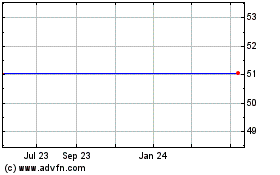By Selina Williams
LONDON-- Royal Dutch Shell PLC's $50 billion takeover of BG
Group PLC, expected to complete Feb. 15, brings to an end a company
that rose from humble beginnings to become the U.K.'s third largest
oil and natural gas business.
In the three decades since BG sprung out of the U.K.'s
struggling state-run gas firm, it has become an international
energy company with assets including highly prized oil fields in
Brazil, huge gas resources off Tanzania and a giant facility in
Australia to liquefy natural gas. Its LNG business became a pioneer
in trading the fuel around the world.
Investors were also attracted by BG's promises of growth
underpinned by exploration success and an entrepreneurial corporate
culture that allowed it to move quickly into new areas, where
bigger companies were slower to act.
The quality of BG's assets, and more recently its weakening
share price, had long made it a prime candidate for takeover,
bankers and analysts said. Shell seized the opportunity last April
after oil prices fell some 50%.
This Friday, Feb. 12, is BG's last trading day.
"BG was a small and very successful business," said Chris
Wheaton, a portfolio manager at Allianz Global Investors, which
holds BG and Shell stock. "It became very cash generative and then
became a victim of its own success."
Analysts have said BG's gas assets will help transform Shell
into one of the world's largest LNG producers. With BG's deep water
Brazilian oil fields, the Anglo-Dutch giant will revive its sagging
resource base, under pressure from the latest drop in oil
prices.
Shell bought a company that had been a good bet for
shareholders. Since 1990, its share price has risen over 800%,
compared with an increase in Shell's stock of around 165% and a
rise of some 200% in the FTSE's oil and gas index. BG's shares
first floated in London in 1986 at 63 pence.
"BG has been an amazing creation of value," said Ivor Pether, a
fund manager at U.K.-based Royal London Asset Management and
investor in BG and Shell. "They were very successful at exploration
and were one of the first companies to globalize their LNG
opportunities," he added.
Wood Mackenzie expects the global LNG market to expand by 50%
from now until 2020, despite a current oversupply of LNG, as
environmental regulations against more polluting fuels like coal
and oil prompt a switch into cleaner burning natural gas.
BG's roots were in LNG.
In the mid-1950s, a decade before North Sea gas was discovered,
BG's forerunner--Britain's state-owned Gas Council--began looking
at importing LNG as a fuel source for the energy-starved country.
In 1959, it delivered the first international transportation of the
fuel from Lake Charles, in the U.S., to Britain's Canvey
Island.
It was a stormy 23-day voyage on the converted naval vessel, but
the experiment worked, paving the way for the world's first LNG
export scheme--a 15-year contract with Algeria to supply just under
1 million tons a year to the U.K. using two British-built LNG
tankers.
BG's then Chief Executive Frank Chapman saw an opportunity to
increase its LNG business with shipments to the U.S. in the early
2000s. The company leased tankers and purchasing capacity at the
very same Lake Charles facility from which they had brought a cargo
to the U.K. some 40 years earlier.
"I remember convincing our board wasn't straightforward," Mr.
Chapman said in a 2012 speech.
The company built up a portfolio of long-term contracts and
short-term LNG cargoes. It diverted shipments to the highest paying
markets, such as those in Asia, where it could charge a high spot
price, while also fulfilling longer-term contracts elsewhere.
"A complete shift in the LNG paradigm," Mr. Chapman called it in
his speech.
BG now has around 30 LNG ships on the water at any one time and
delivered 282 cargoes of LNG in 2015, more than double the previous
year.
The company grew, picking up assets in Egypt, Trinidad and
Tobago, Kazakhstan and the U.S. It also benefited from being an
early mover into Brazil, making a set of blockbuster exploration
successes offshore between 2006 and 2009.
Its production increased from about 300,000 barrels of oil
equivalent a day in 2001 to 704,000 boe/day in 2015.
The company's successes came with challenges.
BG got bogged down in complex projects and failed to meet its
own deadlines and production targets. Costs overran in Australia
and profits were downgraded. It took big write downs as U.S. gas
prices crumbled.
By the time Mr. Chapman left at the end of 2012, the company's
share price was down around 30% from the beginning of the year.
A period of turmoil followed. The next CEO Chris Finlayson
stepped down after just 16 months, leaving a gap of almost a year
before a new chief, Helge Lund, took over. BG's share price fell
around a third in 2014.
Just weeks after Mr. Lund started at the company in February
2015, Shell moved in with its offer for BG.
Write to Selina Williams at selina.williams@wsj.com
(END) Dow Jones Newswires
February 12, 2016 00:44 ET (05:44 GMT)
Copyright (c) 2016 Dow Jones & Company, Inc.
Royal Dutch Shell (NYSE:RDS.A)
Historical Stock Chart
From Mar 2024 to Apr 2024

Royal Dutch Shell (NYSE:RDS.A)
Historical Stock Chart
From Apr 2023 to Apr 2024
